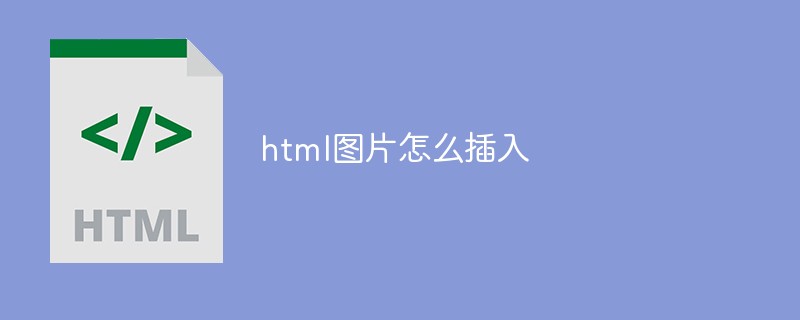How to insert html pictures
In HTML, pictures can be inserted through the
tag. The inserted code is such as "<img src="dinosaur.jpg">", where the src attribute contains a pointer to the picture we want to introduce. The path can be a relative path or an absolute URL.

The operating environment of this article: windows7 system, HTML5&&CSS3 version, DELL G3 computer.
We can use the element to put images on the web page. It is an empty element (it does not need to contain text content or a closing tag) and requires at least one src (usually read as its full name, source) to make it effective. The src attribute contains the path to the image we want to include, which can be a relative path or an absolute URL, just like the href attribute of the element.
Note: Before continuing, you should read the Quick Start URLs and Paths to review relative and absolute URLs.
For example, if you have an image named dinosaur.jpg, and it is stored in the same path as your HTML page, then you can embed it like this:
<img src="dinosaur.jpg">
If this picture is stored in the images folder with the same path as the HTML page (this is also recommended by Google, which is beneficial to SEO/indexing), then you can use the following form:
<img src="images/dinosaur.jpg">
and so on.
Note: Search engines also read the filenames of images and count them towards SEO. Therefore you should give your image a descriptive filename: dinosaur.jpg is better than img835.png.
You can also use absolute paths like the following:
<img src="https://www.example.com/images/dinosaur.jpg">
But this method is not recommended. Doing so will only make the browser do more work, such as re-passing DNS Then look for the IP address. Usually we put images and HTML on the same server.
[Recommended learning: HTML video tutorial]
The above is the detailed content of How to insert html pictures. For more information, please follow other related articles on the PHP Chinese website!

Hot AI Tools

Undresser.AI Undress
AI-powered app for creating realistic nude photos

AI Clothes Remover
Online AI tool for removing clothes from photos.

Undress AI Tool
Undress images for free

Clothoff.io
AI clothes remover

Video Face Swap
Swap faces in any video effortlessly with our completely free AI face swap tool!

Hot Article

Hot Tools

Notepad++7.3.1
Easy-to-use and free code editor

SublimeText3 Chinese version
Chinese version, very easy to use

Zend Studio 13.0.1
Powerful PHP integrated development environment

Dreamweaver CS6
Visual web development tools

SublimeText3 Mac version
God-level code editing software (SublimeText3)

Hot Topics
 1386
1386
 52
52
 Table Border in HTML
Sep 04, 2024 pm 04:49 PM
Table Border in HTML
Sep 04, 2024 pm 04:49 PM
Guide to Table Border in HTML. Here we discuss multiple ways for defining table-border with examples of the Table Border in HTML.
 HTML margin-left
Sep 04, 2024 pm 04:48 PM
HTML margin-left
Sep 04, 2024 pm 04:48 PM
Guide to HTML margin-left. Here we discuss a brief overview on HTML margin-left and its Examples along with its Code Implementation.
 Nested Table in HTML
Sep 04, 2024 pm 04:49 PM
Nested Table in HTML
Sep 04, 2024 pm 04:49 PM
This is a guide to Nested Table in HTML. Here we discuss how to create a table within the table along with the respective examples.
 HTML Table Layout
Sep 04, 2024 pm 04:54 PM
HTML Table Layout
Sep 04, 2024 pm 04:54 PM
Guide to HTML Table Layout. Here we discuss the Values of HTML Table Layout along with the examples and outputs n detail.
 HTML Input Placeholder
Sep 04, 2024 pm 04:54 PM
HTML Input Placeholder
Sep 04, 2024 pm 04:54 PM
Guide to HTML Input Placeholder. Here we discuss the Examples of HTML Input Placeholder along with the codes and outputs.
 HTML Ordered List
Sep 04, 2024 pm 04:43 PM
HTML Ordered List
Sep 04, 2024 pm 04:43 PM
Guide to the HTML Ordered List. Here we also discuss introduction of HTML Ordered list and types along with their example respectively
 Moving Text in HTML
Sep 04, 2024 pm 04:45 PM
Moving Text in HTML
Sep 04, 2024 pm 04:45 PM
Guide to Moving Text in HTML. Here we discuss an introduction, how marquee tag work with syntax and examples to implement.
 HTML onclick Button
Sep 04, 2024 pm 04:49 PM
HTML onclick Button
Sep 04, 2024 pm 04:49 PM
Guide to HTML onclick Button. Here we discuss their introduction, working, examples and onclick Event in various events respectively.




